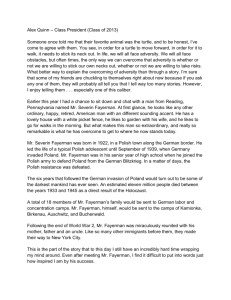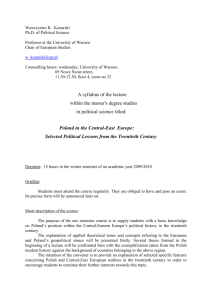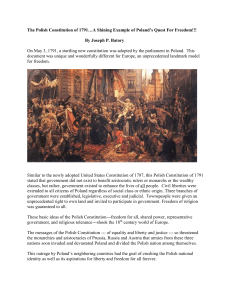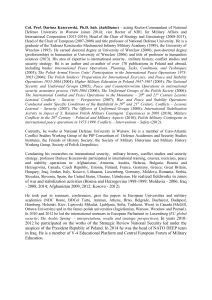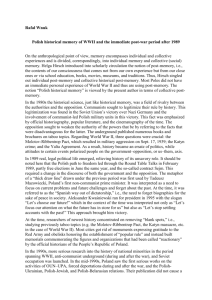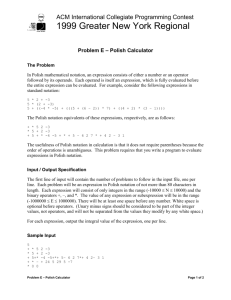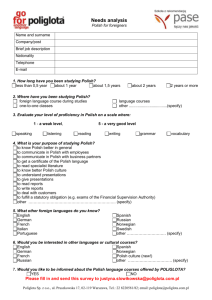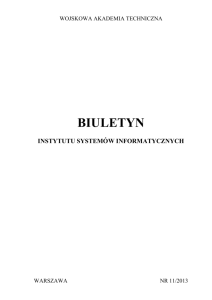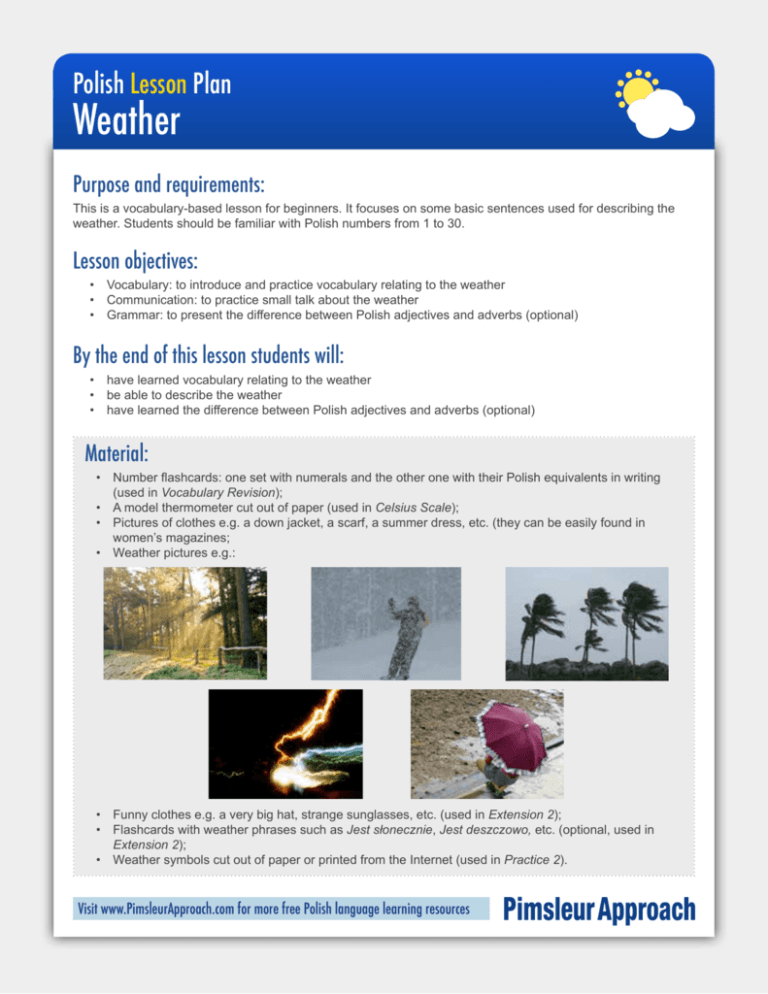
Polish Lesson Plan
Weather
Purpose and requirements:
This is a vocabulary-based lesson for beginners. It focuses on some basic sentences used for describing the
weather. Students should be familiar with Polish numbers from 1 to 30.
Lesson objectives:
• Vocabulary: to introduce and practice vocabulary relating to the weather
• Communication: to practice small talk about the weather
• Grammar: to present the difference between Polish adjectives and adverbs (optional)
By the end of this lesson students will:
• have learned vocabulary relating to the weather
• be able to describe the weather
• have learned the difference between Polish adjectives and adverbs (optional)
Material:
• Number flashcards: one set with numerals and the other one with their Polish equivalents in writing
(used in Vocabulary Revision);
• A model thermometer cut out of paper (used in Celsius Scale);
• Pictures of clothes e.g. a down jacket, a scarf, a summer dress, etc. (they can be easily found in
women’s magazines;
• Weather pictures e.g.:
• Funny clothes e.g. a very big hat, strange sunglasses, etc. (used in Extension 2);
• Flashcards with weather phrases such as Jest słonecznie, Jest deszczowo, etc. (optional, used in
Extension 2);
• Weather symbols cut out of paper or printed from the Internet (used in Practice 2).
Visit www.PimsleurApproach.com for more free Polish language learning resources
Polish Lesson Plan
Weather
Bridge-in
Beginners
1. Vocabulary Review — Numbers 1–30
The teacher distributes 2 sets of flashcards and asks students to match
numerals with their equivalents in writing.
Suggestions for other grade levels
With more advanced students the
teacher can review more numbers
e.g. from 1 to 100 or 1000.
Then, (s)he asks students to count from 1 to 30 (either choosing a
student at random or in turn).
Tips: If a class is small, 2 sets of flashcards should be enough. If there
are more students, the teacher should distribute 2 sets per pair.
2. Celsius Scale
The teacher draws a big thermometer on the board or brings a paper
model of one to class and tells students that people in Poland use
the Celsius scale to measure temperature. In order to help students
compare it with the Fahrenheit scale the teacher should mark 0° and
100° with symbols representing freezing and boiling water.
Now that students know the difference, the teacher shows a picture of a
clothing item e.g. a down jacket and asks Jaka jest temperatura dzisiaj?
(What’s the temperature like today?) and students reply with a number.
For example, a down jacket is suitable for 2°C; a summer dress is
usually worn when it’s around 25°C, etc.
Tips: If students live in a country where Celsius scale is used, there’s
no need to explain how it works.
Visit www.PimsleurApproach.com for more free Polish language learning resources
With more advanced students
it might be a good idea to
practice listening at this stage.
The teacher should find a Polish
weather forecast on the Internet
(there are plenty of videos).
Students can be asked to listen to
it and write down all temperatures
mentioned in a video or the
teacher can distribute simple
maps of Poland and ask students
to match temperatures with the
regions depending on what a
weather forecaster is saying.
Polish Lesson Plan
Weather
Vocabulary Focus
Presentation
The teacher presents basic weather related phrases using pictures. (S)
he shows one photo at a time, describes it in Polish and asks students
to repeat the phrase. Then (s)he sticks the picture on the boards and
writes the phrase next to it.
When all the phrases have been presented with a picture, the teacher
reads each sentence again and asks students to repeat (first all together
and then individually).
Extension 1 (temperature)
The teacher sticks the paper thermometer on the board again and
pointing to a specific number (s)he says e.g.: Jest 5 stopni (It’s 5
degrees Celsius); Są 22 stopnie (It’s 22 degrees Celsius) etc. (S)he
asks students to repeat the sentences, first all together then individually.
In order to help students understand how a sentence changes
depending on a number, the teacher should draw a chart (please check
out an example below).
More advanced students will
probably know most of the basic
vocabulary about the weather.
Consequently it might be a good
idea to present more sophisticated
sentences e.g. using a text about
seasons of the year in Poland or
the weather in Poland in general.
Also, Extension 2 can be easily
adapted for other levels simply
by adding more adverbs and
focusing on the difference
between them and the adjectives
(word endings).
Extension 2 (It’s sunny, it’s rainy, etc.):
If the teacher feels the students are ready for more phrases, (s)he can
introduce the equivalents of the English words It’s rainy, windy, sunny etc.
They all begin with Jest followed by an adverb (unlike in English because
rainy, sunny, windy are all adjectives). In order to present these phrases
the teacher should bring a set of clothes to class (one item for each
phrase). Saying e.g. Jest mroźno (It’s freezing), (s)he should put some
gloves on. All of the phrases the teacher wishes to introduce should be
presented in such a way.
For immediate practice the teacher can distribute flashcards with the
phrases (s)he has just presented and putting an item on (s)he should
ask students to pick out a relevant flashcard. Alternatively, one of the
students picks out a flashcard and the other one has to put on an item
suitable for such weather. If the teacher brings clothes which look funny,
this activity can be quite entertaining.
Tips: Whether all the activities above are used with beginners
depends on how many Polish words they already know and how long
a single lesson lasts. Generally, it’s not advisable to introduce too
many new words at once.
Practice 1
The teacher distributes Worksheet 1 or Worksheet 2 for students to
practice weather phrases and expressions.
Visit www.PimsleurApproach.com for more free Polish language learning resources
Depending on students’ level and
activities used earlier the teacher
should develop exercises relevant
to what has just been taught.
Polish Lesson Plan
Weather
Practice 2
The teacher tells students to imagine they’re calling a friend living in
Poland. The task is to ask him/her about the weather (Jaka jest teraz
pogoda w Polsce? What’s the weather like in Poland now?). Student A
(Polish friend) has his/her answer expressed by means of a symbol (e.g.
if she/he has a symbol of the sun, she/he should say: Świeci słońce.
Jest ciepło. Jest 20° C). Student B has his/her own set of symbols and
listening to Student A (s)he has to choose the one Student A is talking
about. Student A should be asked not to show his/her symbol to Student
B.
More advanced students will
be able to act out dialogues
about the weather using more
vocabulary and a variety of
sentence structures. Instead of
weather symbols the teacher
should distribute e.g. short texts
which students can use to get
their conversation going.
Follow-up
Depending on the amount of time left the teacher can assign homework or ask students to do exercises in
Worksheet 2 or Quizzes.
Example (for Extension 1)
Jest
stopni.
Są
5, 6, 7, 8, 9, 10, 11, 12, 13, 14, 15, 16, 17, 18, 19, 20,
21, 25, 26, 27, 28, 29, 30
Copyright © 2000-2012 Internet Order, LLC. All rights reserved. “Stroll” and “Internet Order” are trademarks of Internet Order,
LLC. Internet Order, LLC sells Pimsleur® products but is not an affiliate of Simon & Schuster, Inc. (the publisher of Pimsleur®
products) or of Beverly Pimsleur (the owner of the Pimsleur® trademark, which is licensed exclusively to Simon & Schuster).
Any use of the Pimsleur® name or associated marks is solely to identify the products sold by Internet Order, LLC. Internet
Order, LLC is solely responsible for the contents of this document.
Visit www.PimsleurApproach.com for more free Polish language learning resources
stopnie.
2, 3, 4, 22, 23, 24


